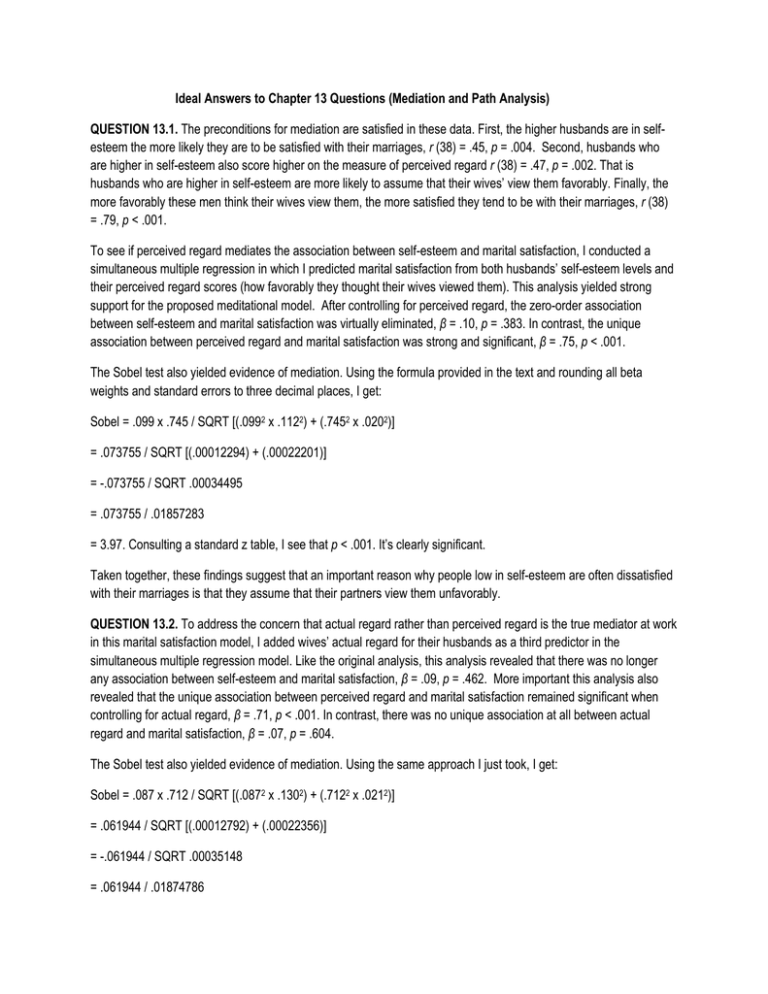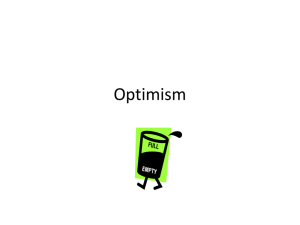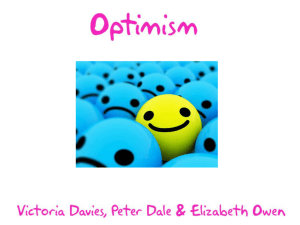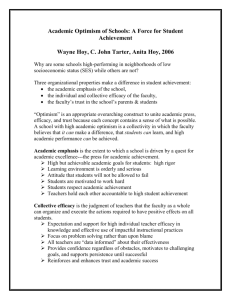Pelham Ch 13 Answers
advertisement

Ideal Answers to Chapter 13 Questions (Mediation and Path Analysis) QUESTION 13.1. The preconditions for mediation are satisfied in these data. First, the higher husbands are in selfesteem the more likely they are to be satisfied with their marriages, r (38) = .45, p = .004. Second, husbands who are higher in self-esteem also score higher on the measure of perceived regard r (38) = .47, p = .002. That is husbands who are higher in self-esteem are more likely to assume that their wives’ view them favorably. Finally, the more favorably these men think their wives view them, the more satisfied they tend to be with their marriages, r (38) = .79, p < .001. To see if perceived regard mediates the association between self-esteem and marital satisfaction, I conducted a simultaneous multiple regression in which I predicted marital satisfaction from both husbands’ self-esteem levels and their perceived regard scores (how favorably they thought their wives viewed them). This analysis yielded strong support for the proposed meditational model. After controlling for perceived regard, the zero-order association between self-esteem and marital satisfaction was virtually eliminated, β = .10, p = .383. In contrast, the unique association between perceived regard and marital satisfaction was strong and significant, β = .75, p < .001. The Sobel test also yielded evidence of mediation. Using the formula provided in the text and rounding all beta weights and standard errors to three decimal places, I get: Sobel = .099 x .745 / SQRT [(.0992 x .1122) + (.7452 x .0202)] = .073755 / SQRT [(.00012294) + (.00022201)] = -.073755 / SQRT .00034495 = .073755 / .01857283 = 3.97. Consulting a standard z table, I see that p < .001. It’s clearly significant. Taken together, these findings suggest that an important reason why people low in self-esteem are often dissatisfied with their marriages is that they assume that their partners view them unfavorably. QUESTION 13.2. To address the concern that actual regard rather than perceived regard is the true mediator at work in this marital satisfaction model, I added wives’ actual regard for their husbands as a third predictor in the simultaneous multiple regression model. Like the original analysis, this analysis revealed that there was no longer any association between self-esteem and marital satisfaction, β = .09, p = .462. More important this analysis also revealed that the unique association between perceived regard and marital satisfaction remained significant when controlling for actual regard, β = .71, p < .001. In contrast, there was no unique association at all between actual regard and marital satisfaction, β = .07, p = .604. The Sobel test also yielded evidence of mediation. Using the same approach I just took, I get: Sobel = .087 x .712 / SQRT [(.0872 x .1302) + (.7122 x .0212)] = .061944 / SQRT [(.00012792) + (.00022356)] = -.061944 / SQRT .00035148 = .061944 / .01874786 = 3.30. Consulting a standard z table, I find that p = .001 (after rounding upward). It’s clearly significant. These supplemental analyses provide stronger support for the dependency regulation model than the original model because they rule out the potential confound of actual regard. Apparently, it is how men think their wives evaluate them, rather than how their wives actually do evaluate them, that explains why self-esteem is related to marital satisfaction. QUESTION 13.3. The final model with all of the path coefficients that proved to be significant appears in Figure 13.1. The results generally supported predictions. Not surprisingly, health at time 1 was positively related to optimism and to specific health expectancies. Further these two health-related beliefs were strongly correlated with each other. That is, optimists were much more likely than pessimists to believe that engaging in healthy behavior leads to greater physical health. Figure 13.1 Final Path Model Predicting Longevity from Health Beliefs and Health Behavior Note to Instructors: A common student mistake is to fail to include variables at the same level as the criterion in the middle level models (e.g., to fail to include diet along with the three upstream variables when predicting adherence). Interestingly, the two different health-related beliefs did not predict the same behaviors. Whereas optimists were more likely than pessimists to eat a healthy diet (including getting enough to eat), there was no unique association between optimism and adherence. That is, optimists were not more likely than pessimists to take their medication regularly. In contrast to this pattern, specific health-related expectancies (including but not limited to attitudes about medication) did predict adherence but did not predict diet. This pattern of findings suggests that despite their strong correlation, optimism and specific health-related expectancies are not the same thing. Optimism seems to drive healthier eating whereas more positive health expectancies seem to drive greater medical adherence. These path analyses also showed that people who were healthier at time 1 were more likely to eat healthy and to adhere to medical instructions regarding medication at time 2. Perhaps differences in healthy habits were part of the reason these people differed in time 1 health to begin with. The beliefs and behaviors in this model appear to have been sufficiently powerful to predict longevity in this longitudinal sample. First, a direct path from time 1 health to longevity indicated that, all else being equal, people who were healthier at time 1 tended to live longer than people who were less healthy at time 1. There was also a direct path for optimism. Above and beyond the role optimism played in promoting healthy eating, there was an additional effect of optimism. Whether this direct route reflects psychological or physiological benefits of optimism (e.g., a stress-buffering role) or whether it means that optimism promoted healthy behavior not measured in this study (e.g., exercise, excessive drinking) would be a good topic for future research. Although there was no direct effect of health-related expectancies on longevity, these health-related expectancies did significantly predict adherence, which significantly predicted longevity. Thus, the route through which health-related expectancies influence longevity seems to be adherence. In addition to the direct effect noted previously, optimism also predicted longevity by means of behavior. Specifically, optimism significantly predicted healthy eating, and healthy eating was a significant predictor of longevity. Thus optimism had both a direct and an indirect (mediated) effect on longevity. Despite the use of a longitudinal design, this study had some limitations. Perhaps the most important limitation was the fact that we only assessed two different health-related behaviors. Assessing body mass and patterns of regular exercise, for example, could have yielded additional information. For example, the direct path for optimism might prove to be mediated by some of the healthy behaviors not assessed in this study. Along similar lines, it would also be useful to incorporate measures of stress, social support, and immune system responses (e.g., cortisol levels) in a similar study. The availability of such measures would surely provide a more complete picture of why some people live longer than others.






